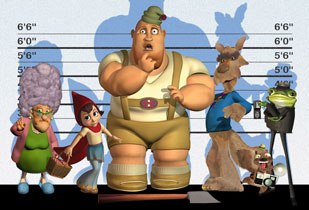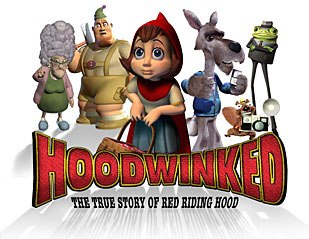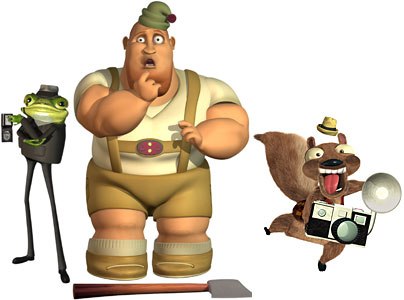J. Paul Peszko talks to the makers of Hoodwinked, the first independently produced 3D animated feature in the Philippines.

There are lessons to be learned from the making of Hoodwinked: The True Story of Red Riding Hood, an independently produced 3D animated feature that refashions the familiar fairy tale as Rashomon. Although we may think we already know them, those of us who have any desire to break into indie features should pay special attention.
Lesson #1: Its Not What You Know But Who You Know
While the unique way that Hoodwinked came together points to this time-honored Hollywood adage, theres an important corollary inferred by one of the films producers, Sue Bea Montgomery: When preparation meets opportunity, magic can happen.
The two magicians in this case are the Edwards brothers, Cory and Todd, who spent many hours on the front lawn and streets of their Tulsa neighborhood, acting out adventure films on Super 8. We had storyboards, miniatures, stunts and had screenings of our finished masterpieces for friends, said Cory Edwards, Hoodwinkeds director and co-writer. It has been a life-long love affair that few folks around us have ever understood.
Lesson #2: Learn to Crawl Before You Can Walk
When Cory and Todd Edwards started Blue Yonder Films in Tulsa with several trusted friends, like any small company they had to hack away at the usual commercials and industrial videos for local businesses and ad agencies. Then in 1997 they decided to make a live-action feature. The Oklahoma Film Commission gave them the phone number for Montgomery, a Hollywood veteran and Tulsa native. Together, they raised money from friends and investors who believed in their vision. After a year-and-a-half, utilizing nearly every actor they knew and every location they could finagle for free, they finished Chillicothe, a comedy/drama written and directed by Todd about the pains of leaving the secure cradle of college friends to make something of your life. The film premiered at Sundance in 1999, but remained in the shadow of The Blair Witch Project, that years Sundance winner. So, it was back to nuts n bolts again but not for long.
Lesson #3: Networking: Keep an Eye on Your Friends
Although Cory used to work for a midwest animation company during his summers off from school, he and his brother hoped to make their living in live action. But another longtime friend, Benjy Gaither, who had started his own animation company in Indiana, Live Bait Prods., offered to partner with them. That created an opportunity for Cory to cut his teeth on LightWave 3D and direct several short-form animated sing-along videos. But both Edwards brothers still had their sights and their creative imaginations set higher.



As a creative person, you grow up keeping tabs on your other friends or your other associates and what theyre doing, Cory explained. So as we were coming up in our part of the world [Tulsa], he [Gaither] was also coming up in his part of the world [Indiana], raising money and he had backing for other creative projects. So, he saw the right idea, and we saw he had the money and wanted to do it.
That right idea was Wobots. The 45-minute animated feature, which Cory wrote and directed, was about a young boy with a speech impediment who befriends misfit robots sent to a junk heap to rot. I wrote that, designed the characters, designed every ship and prop, storyboarded every shot, Cory explained. It was one of those labor of love things.
While they were finishing Wobots, Montgomery, who associate produced Chillicothe and had worked on a number of features such as The Shawshank Redemption and Air Force One, and was then working at Disney as manager of post-production in the feature animation division, tried to pave the way for them. Easier said then done. I just couldnt tell people enough about how talented they were and I tried to open doors all over town, but some people in very high circles didnt want to hear it. In many ways, the studios where I worked were closed shops. I knew that the brothers would have to find their level on the independent side before anyone would pay attention.
However, Montgomery had maintained her connections with investors who had put money into Chillicothe. One of those was her longtime friend, Maurice Kanbar, the inventor of Skyy Vodka and the elastic material used to make Spandex. In addition to his other ventures, Kanbar has long been associated with the motion picture industry. In 1971, he invented the concept of the multiplex theater when he opened the Quad Cinemas in New York. His Kanbar Film and Television Institute at NYU works with and supports upcoming filmmakers. So, Montgomery got the Edwards brothers a meeting with Kanbar.
Lesson #4: Go with the Flow
As a screenwriter, I can tell you theres nothing deadlier than that long silence after you pitch your best idea and the executive asks, So, what else do you have? In this case, the other thing that the Edwards brothers had was Wobots. When he [Kanbar] saw this computer animation [Wobots], we found out, lo and behold, hes a big animation buff, Cory recalled. And he just took off on the idea of an animated feature. Kanbar told them that he would love to do something that put a hip spin on a traditional story the way Walt Disney used to do. He gave them a month to come up with a concept.
A few nights later, Todd called his brother and asked him what he thought about Little Red Riding Hood told from multiple points of view like Rashomon. This multi-layered storytelling technique where you treat the fairy tale like a crime scene intrigued Cory. You take each characters view of the story, and the story gets more and more crazy and different. So, Cory said, OK, thats a story Im willing to invest two years of my life in. I can get excited about that. From there, Cory and Todd bounced the story back and forth and developed a clever scenario.
Furry and feathered cops from the animal world investigate a domestic disturbance at Grannys cottage, involving Red Riding Hood, the Wolf, Granny and the Woodsman. The charges are many: breaking and entering, disturbing the peace, intent to eat and wielding an axe without a license. Not to mention, this case might be tied to the elusive Goody Bandit who has been stealing the recipes of goody shops everywhere. Investigator Nicky Flippers arrives to hear all four fours sides of the days events.
Im calling it 3D storytelling because, as one event is happening in one characters day, we retell the day, and some of the paths will cross later in the movie, Cory explained. So, youll have something set up in one characters day that gets paid off later in the movie at that same point in the day from another characters perspective.
Kanbar paid off the Edwards brothers, so to speak, when they walked back in his office and pitched him their new idea. He decided to finance the entire production without even asking to see a finished script. How much is that? Way, way under the radar, as Cory put it. The official company line is that its just under $15 million.
What does Cory think other filmmakers can learn from all this? For anybody that is looking for financing or wanting to do something like this, its kind of like looking at who you know and who they know. It does take several years to find those opportunities.
It was vital for the Edwards brothers to put together a production team with significant experience. Montgomery brought in veteran Disney animation producer David Lovegren (Little Mermaid II: Return to the Sea and Fantasia 2000). Lovegren developed a production plan that made sense within Kanbars budget parameters. Offered Lovegren, Six or seven years ago, the idea of doing Hoodwinked as an independent [animated] feature would have been impossible. Animation was just too expensive and only major companies like Disney could afford budgets that reached a million dollars a minute. However, technology has benefited the independent film companies. Today filmmakers can buy production software that allows them to create theatrical style animation at acceptable cost levels.
After Lovegren joined forces with Montgomery and longtime friend and partner of the Edwards brothers, Preston Stutzman, they hired editor Tony Leech to initially cut the first story reel for the project. Leech became so helpful in guiding the creative process that he was hired as a full-time editor on the project and now shares directing credit with the Edwards brothers.
But what about animators? The team couldnt just walk over to Disney or DreamWorks and borrow theirs. Fortunately, Lovegren had been sent to Manila in 2001 to start up a hands-on independent animation studio and hire a team of animators to crank out cost-conscious cartoons and animated features. Unfortunately, the sales team couldnt lure any productions there and the whole enterprise folded, forcing the animators to seek alternative employment. In January 2002, Lovegren and Montgomery, with Kanbars backing, hired about 20 of those animators and created their own studio in a 5,000 square foot rented house in Manila. Thus, Hoodwinked represents the first independently produced 3D animated feature in the Philippines.
One of the most important people to join the team was visual effects producer Robert Shajer, whos been working in CG for 10 years. He began with ABC News during the Gulf War then moved to Los Angeles and worked as a PA at Rhythm & Hues, moving to coordinator and eventually to producer of special venues. Then he went to Dreamquest, where he produced Inspector Gadget and Mission to Mars. Next he spent two years working on the pre-production and production on The Lord of the Rings: The Fellowship of the Ring at Weta Digital in New Zealand as the digital producer. He had just come off of Scooby Doo 2: Monsters Unleashed for Meteor Studios before joining Hoodwinked. Shajer agrees with Cory Edwards that we are on the edge of a wave that is definitely coming in independent feature animation because of the accessibility and cost-effectiveness of new technology.
They used a Maya software package composed of Maya and Render Maya. Half of the work was done with 4.5 the other half with 5.01.1. Due to the fact that they are independents and are working on a budget of about $15 million, they could not afford to go chasing after upgrades. We know we [couldnt] be Monsters, Inc., so [we picked] a style that we could achieve well on this budget, instead of trying to overachieve and doing it poorly, Cory said.
Corys artistic vision harkened back to the days of Rankin/Bass animated stop-motion and the work of Henry Selick. Cory loved that nostalgic look and thought, If we approach our look like that photographed miniatures in stop-motion - and if that nostalgia resonates with our audience as far as that look, then were not going to shoot ourselves in the foot trying to put every freckle and hair on photoreal creatures.
Not only can independents produce an animated feature these days, they can do it much faster. The reason for this lies in studio methodology. Added Shajer, [A studio] tends to want to review the entire movie and then go back and rewrite it. When a studio starts seeing what their movie is ultimately going to look like, thats when they start backpedaling and saying, Oh, wait! Lets try and move in another direction with this. And thats where they get into rewrites, changing of technology and changing what the movies all about. The advantage that we have in an independent feature is that our investor [Kanbar], whos very excited about the prospects, has bought off on the concept and is entrusting us with following through with our own vision. And thats really where Cory is so key. Hes the hub of this entire project because hes got the entire movie playing in his head and he knows what hes going after.

Also, whereas a studio might demand that every creature have displacement fur, Cory stated, were going for a variety of looks so that every animal does not have to have the same 100% thick fur that is going to bog us down and we wont be able to finish. Slajer added, Were ranging all the way from wind-blown dynamic fur to fairly, what I call clumped fur, which wont have any wind dynamic because it really wouldnt be perceptible.
So what exactly is Cory going after? Ive really directed this thing looking at it as an action/comedy first and an animated film second. I know kids will love it because it has animated animals, but weve written it to [have] a wider appeal. I like comedy and animation that is really fast, really zippy [like the old Bugs Bunny cartoons]. One of my pet peeves with animation is how slow some of it goes, especially computer animation. For some reason, it treats the audience like were all in slow motion.
Weve written this to be as funny as it can possibly be for even people our age. At the outset, it may look like just a childrens film, but, like many of the Pixar films or the best of the Disney films, it spreads all the way up to an older age bracket.
Hoodwinked, meanwhile, features the veteran voice talents of Tara Strong (Ice Age), Patrick Warburton (The Emperors New Groove), Andy Dick (Dr. Doolittle 2), Sally Struthers (The New Adventures of Mother Goose) and David Ogden Stiers (Lilo & Stitch).
Of course, Disney and Pixar have their own marketing and distribution machines. What about Hoodwinked? Domestically, said Lovegren, weve had great luck through our personal contacts, getting the major studios to screen the film for possible distribution. Internationally, Kanbar has hired Edward Noeltners Cinema Management Group LLC, who has already received firm distribution offers from more than 10 territories, including Spain (Manga Films), Portugal (LNK Audiovisuais), Benelux (Les Films de LElysee), Israel (Shani Films) and the Middle East (Italia Films). Noeltner is finalizing a number of those agreements before leaving for Cannes, where CMG will screen an in-progress version of Hoodwinked on May 14 and 16. Final completion is on target for August.
J. Paul Peszko is a freelance writer and screenwriter living in Los Angeles. He writes various features and reviews as well as short fiction. He currently has a feature comedy in development and has just completed his second novel. When he isnt writing, he teaches communications courses.









